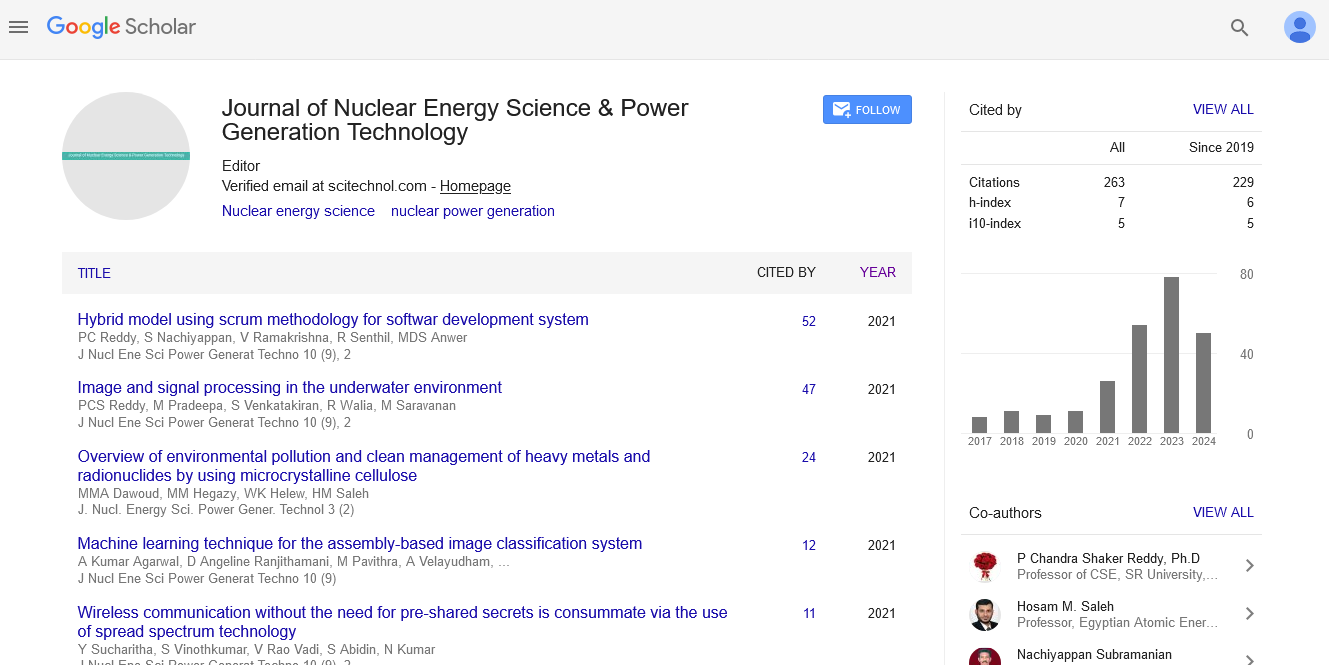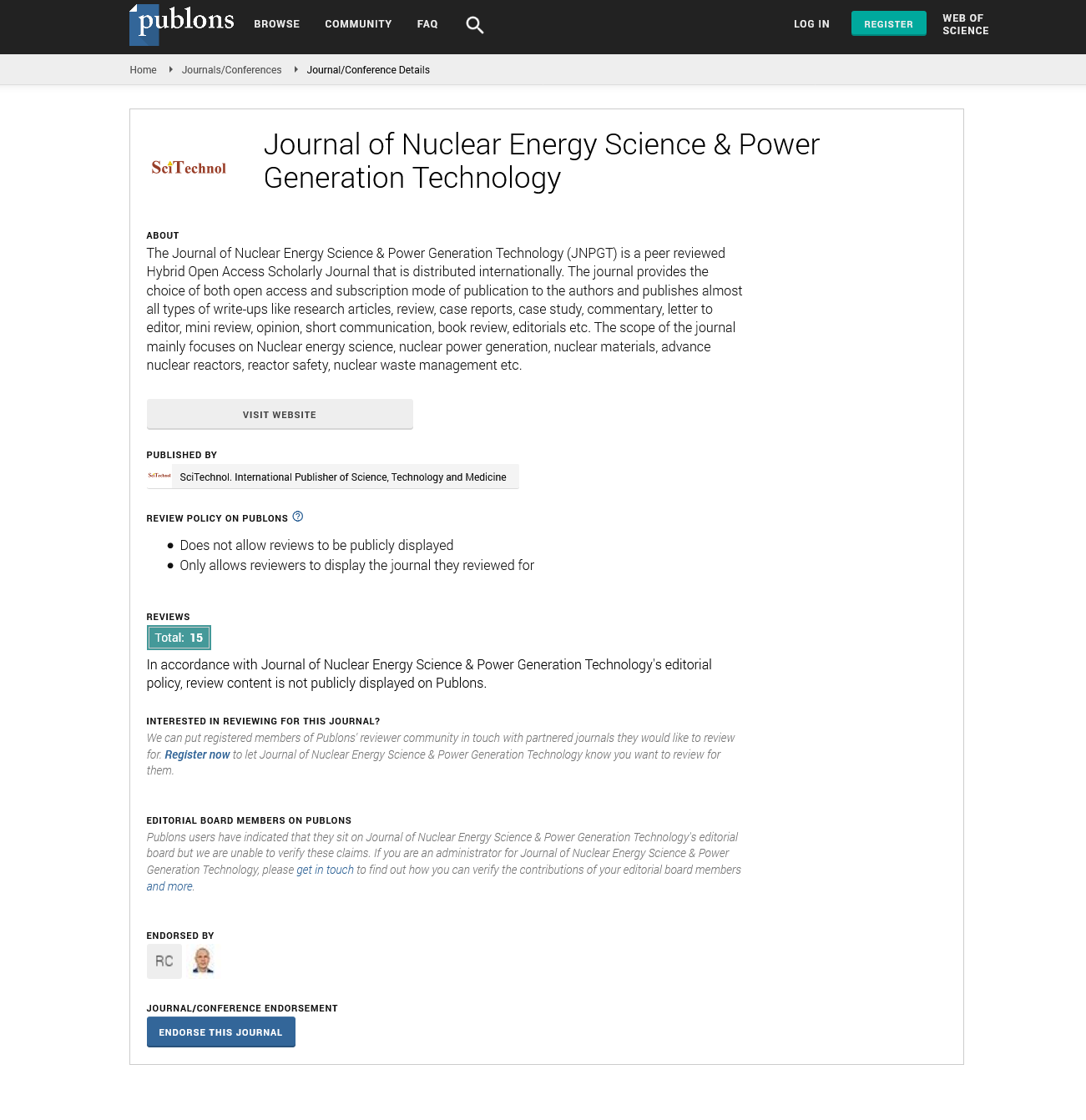Short Communication, J Nucl Ene Sci Power Generat Technol Vol: 13 Issue: 4
Evaluating the Impact of Solid-State Batteries on Grid Stability
Deniwe Riens*
1Department of Electrical Engineering, University of New York, New York, USA
*Corresponding Author: Deniwe Riens,
Department of Electrical Engineering, University of New York, New York, USA
E-mail: deniewe_riens@gmail.com
Received date: 17 June, 2024, Manuscript No. JNPGT-24-143379;
Editor assigned date: 19 June, 2024, PreQC No. JNPGT-24-143379 (PQ);
Reviewed date: 03 July, 2024, QC No. JNPGT-24-143379;
Revised date: 11 July, 2024, Manuscript No. JNPGT-24-143379 (R);
Published date: 18 July, 2024, DOI: 10.4172/2325-9809.1000412.
Citation: Riens D (2024) Evaluating the Impact of Solid-State Batteries on Grid Stability. J Nucl Ene Sci Power Generat Technol 13:4.
Description
Grid stability is an essential part of modern electricity networks, ensuring a reliable supply of power despite varying demand and generation conditions. With the increasing integration of renewable energy sources and the growing complexity of electrical grids, maintaining stability has become more challenging. This explores the importance of grid stability, the factors affecting it, and the technologies and strategies employed to ensure a stable and resilient power supply [1-3]. Grid stability refers to the ability of an electrical grid to maintain continuous power supply and proper voltage levels despite disturbances or fluctuations in demand and generation. Stable grids are essential for preventing blackouts, maintaining the quality of power delivered to consumers, and ensuring the safe and efficient operation of electrical equipment. Unstable grids are more disposed to blackouts, which can disrupt daily life, affect businesses, and cause significant economic losses [4]. Fluctuations in voltage and frequency can damage sensitive electrical equipment, leading to costly repairs and replacements. Power instability can disrupt industrial processes, leading to production losses and economic inefficiencies.
Factors affecting grid stability
The increasing use of renewable energy sources like wind and solar introduces variability in power generation. Unlike traditional power plants, renewable sources are dependent on weather conditions, making it challenging to predict and balance supply and demand. Changes in consumer behavior, industrial activity, and seasonal variations can cause significant fluctuations in power demand. Managing these fluctuations is vital for maintaining grid stability [5-8]. The capacity and efficiency of transmission networks play a vital role in grid stability. Congestion in transmission lines can lead to bottlenecks, affecting the distribution of power and causing instability. Modern grids are becoming increasingly complex, with multiple interconnections and diverse sources of power generation. This complexity can make it difficult to manage and control the grid effectively. As grids become more digitized and connected, they are also more vulnerable to cyberattacks, which can disrupt operations and componential stability [9,10].
Technologies and strategies for ensuring grid stability
Energy storage technologies, such as batteries and pumped hydro storage, play a vital role in maintaining grid stability. These systems can store excess energy generated during periods of low demand and release it during peak demand, helping to balance supply and demand. Demand response strategies involve incentivizing consumers to reduce or shift their energy usage during peak periods. By managing demand, these programs can alleviate stress on the grid and enhance stability. Modern grid management systems utilize advanced sensors, data analytics, and artificial intelligence to monitor and control the grid in real-time. These systems can quickly detect and respond to disturbances, improving grid reliability and stability. Incorporating flexible generation sources, such as natural gas plants and hydroelectric power, can help manage variability in renewable energy generation. These sources can be ramped up or down quickly to match supply with demand. Upgrading transmission and distribution infrastructure is essential for improving grid stability. This includes investing in smart grids, which use digital technology to enhance the monitoring and management of the grid, and increasing the capacity and efficiency of transmission lines. Microgrids are localized grids that can operate independently or in conjunction with the main grid. They enhance resilience by providing a backup power source during grid disturbances and can integrate renewable energy sources more effectively.
Conclusion
Maintaining grid stability is a complex but essential task in ensuring a reliable and efficient power supply. The challenges posed by the integration of renewable energy, demand fluctuations, and grid complexity require innovative solutions and advanced technologies. Energy storage systems, demand response programs, advanced grid management, flexible generation, grid modernization, and microgrids all play vital roles in achieving a stable and resilient electrical grid. As the energy landscape continues to evolve, ongoing research and investment in grid stability solutions will be vital. By embracing these technologies and strategies, we can build a more robust and reliable grid that meets the demands of the future while supporting the transition to cleaner and more sustainable energy sources.
References
- Hong S, Lee J, Cho H, Kim M, Moon I, et al. (2022) Multi-objective optimization of CO2 emission and thermal efficiency for on-site steam methane reforming hydrogen production process using machine learning. J Clean Prod 359:132133.
- Han JR, Lee JM (2023) Multi-objective optimization of hydrogen production process and steam reforming reactor design. Int J Hydrogen Energy 4(2):647.
- Cherif A, Lee JS, Nebbali R, Lee CJ (2022) Novel design and multi-objective optimization of autothermal steam methane reformer to enhance hydrogen production and thermal matching. Appl Therm Eng 217:119140.
- Han JR, Park SJ, Kim H, Lee S, Lee JM (2022) Centralized and distributed hydrogen production using steam reforming: challenges and perspectives. Sustain Energy Fuels 6(8):1923-1939.
- Durán FJ, Dorado F, Sanchez-Silva L (2020) Exergetic and economic improvement for a steam methane-reforming industrial plant: simulation tool. Energies 13(15):3807.
- Hajjaji N, Pons MN, Houas A, Renaudin V (2012) Exergy analysis: An efficient tool for understanding and improving hydrogen production via the steam methane reforming process. Energy Policy 42:392-399.
- Dybkjær I (1995) Tubular reforming and autothermal reforming of natural gas-an overview of available processes. Fuel Process Techno 42(23):85-107.
- Thévenin D, Janiga G (2008) Optimization and computational fluid dynamics. Springer Science & Business Media
- Han JR, Lee S, Lee JM (2022) Development of 3D CFD model of compact steam methane reforming process for standalone applications. Korean J Chem Eng 39(5):1182-1193.
- Haghi SB, Salehi G, Azad MT, Nichkoohi AL (2020) 3D CFD modeling and optimization of a cylindrical porous bed reactor for hydrogen production using steam reforming of methane. Pet Chem 60:1251-1259.
 Spanish
Spanish  Chinese
Chinese  Russian
Russian  German
German  French
French  Japanese
Japanese  Portuguese
Portuguese  Hindi
Hindi 

